【案例面试】45分钟,你会经历什么
私立学校面试试讲要45分钟
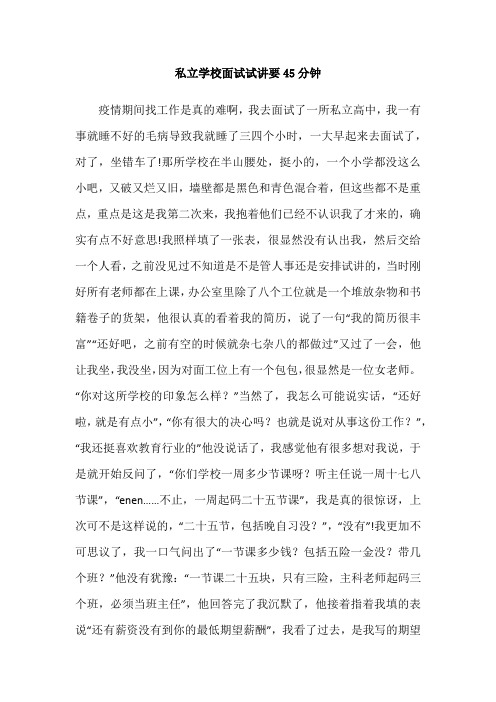
私立学校面试试讲要45分钟疫情期间找工作是真的难啊,我去面试了一所私立高中,我一有事就睡不好的毛病导致我就睡了三四个小时,一大早起来去面试了,对了,坐错车了!那所学校在半山腰处,挺小的,一个小学都没这么小吧,又破又烂又旧,墙壁都是黑色和青色混合着,但这些都不是重点,重点是这是我第二次来,我抱着他们已经不认识我了才来的,确实有点不好意思!我照样填了一张表,很显然没有认出我,然后交给一个人看,之前没见过不知道是不是管人事还是安排试讲的,当时刚好所有老师都在上课,办公室里除了八个工位就是一个堆放杂物和书籍卷子的货架,他很认真的看着我的简历,说了一句“我的简历很丰富”“还好吧,之前有空的时候就杂七杂八的都做过”又过了一会,他让我坐,我没坐,因为对面工位上有一个包包,很显然是一位女老师。
“你对这所学校的印象怎么样?”当然了,我怎么可能说实话,“还好啦,就是有点小”,“你有很大的决心吗?也就是说对从事这份工作?”,“我还挺喜欢教育行业的”他没说话了,我感觉他有很多想对我说,于是就开始反问了,“你们学校一周多少节课呀?听主任说一周十七八节课”,“enen……不止,一周起码二十五节课”,我是真的很惊讶,上次可不是这样说的,“二十五节,包括晚自习没?”,“没有”!我更加不可思议了,我一口气问出了“一节课多少钱?包括五险一金没?带几个班?”他没有犹豫:“一节课二十五块,只有三险,主科老师起码三个班,必须当班主任”,他回答完了我沉默了,他接着指着我填的表说“还有薪资没有到你的最低期望薪酬”,我看了过去,是我写的期望薪酬5000---8000,这么累五千块都没有吗?我看了看门口,下雨了,雨势逐渐变大,而我没有带伞,“你可以回去想清楚了再来”,他把表和简历递给了我,我说好。
我走了,这所学校和我真没有缘分,第一次我不知道这些,但是试讲之后没有通知我第二次给我讲了这么多,我就是出来挣生活费和考试费的,我需要时间来复习,我到了门口,看到校长办公室的门口有两位家长和校长交流,我进来的时候就听到了,关于学费和升学率与十五中的对比,操场上还有前两天举办的两所学校的交流会的牌子,我用手里的纸挡着头顶就出去了,雨真的越来越大,我下山了,在马路边打车,十字路口对面是一座桥,桥下面是一条很深很宽的护城河,已经冒出了很多水汽,这条河里前半个月前死过一个女孩,对面是正在修建的白色为主的市法院,背后靠着墨色的山,前面是护城河,远远看着很气派。
情景模拟面试题目(3篇)
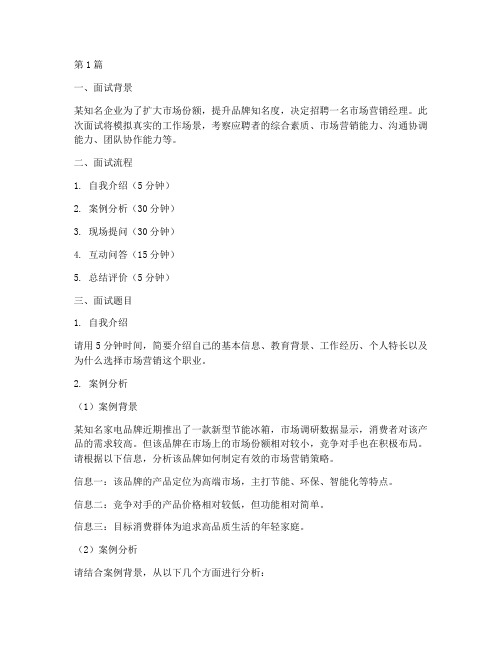
第1篇一、面试背景某知名企业为了扩大市场份额,提升品牌知名度,决定招聘一名市场营销经理。
此次面试将模拟真实的工作场景,考察应聘者的综合素质、市场营销能力、沟通协调能力、团队协作能力等。
二、面试流程1. 自我介绍(5分钟)2. 案例分析(30分钟)3. 现场提问(30分钟)4. 互动问答(15分钟)5. 总结评价(5分钟)三、面试题目1. 自我介绍请用5分钟时间,简要介绍自己的基本信息、教育背景、工作经历、个人特长以及为什么选择市场营销这个职业。
2. 案例分析(1)案例背景某知名家电品牌近期推出了一款新型节能冰箱,市场调研数据显示,消费者对该产品的需求较高。
但该品牌在市场上的市场份额相对较小,竞争对手也在积极布局。
请根据以下信息,分析该品牌如何制定有效的市场营销策略。
信息一:该品牌的产品定位为高端市场,主打节能、环保、智能化等特点。
信息二:竞争对手的产品价格相对较低,但功能相对简单。
信息三:目标消费群体为追求高品质生活的年轻家庭。
(2)案例分析请结合案例背景,从以下几个方面进行分析:1. 市场调研:如何了解目标市场的需求,分析竞争对手的优势和劣势?2. 产品策略:如何突出产品的差异化优势,满足目标消费者的需求?3. 价格策略:如何制定合理的价格策略,提升产品竞争力?4. 渠道策略:如何选择合适的销售渠道,提高市场覆盖率?5. 推广策略:如何利用多种推广手段,提升品牌知名度和美誉度?6. 团队协作:如何与团队成员共同推进市场营销工作,实现销售目标?3. 现场提问(1)请谈谈你对市场营销的定义和作用。
(2)你认为作为一名市场营销经理,应具备哪些素质?(3)你如何处理工作中的压力和挑战?(4)请描述一次你成功策划的市场营销活动,并分析其成功的原因。
(5)你认为如何平衡市场营销和财务预算之间的关系?4. 互动问答(1)你对我们公司有什么了解?(2)你对我们公司的企业文化有什么看法?(3)你对我们公司的产品有什么了解?(4)你对我们公司的竞争对手有什么了解?(5)你对我们公司的发展前景有什么看法?5. 总结评价面试官根据应聘者的表现,进行总结评价,包括以下几个方面:(1)综合素质:考察应聘者的语言表达能力、逻辑思维能力、应变能力等。
汇丰银行面试经历IT类

汇丰银行面试经历IT类
我去年申请汇丰银行IT实习生时,经历了多轮面试与测试,以下是我的面试经历。
第一轮是线上笔试,内容包括英语语法和逻辑题。
考试时间为45分钟,题目难度适中,需要注意的是考试期间不能重
复提交,因此要多加小心。
第二轮是电话面试,面试官主要询问我的个人背景、教育经历和实习经验等一些基本问题,接下来是针对实习岗位的一些技术问题,如常见的前端开发、后端开发和数据库设计等。
面试时需要口语流利、回答的明确简洁,以符合面试官的要求。
第三轮是面对面面试,这一轮主要是与IT部门的高管和团队成员沟通,了解汇丰银行的企业文化与工作方式,以及个人在团队中的工作职责和挑战。
最后要求现场编写一个小程序,以检测我的能力。
最后一轮是技术测试,考察我的IT专业技能和实战经验。
考试时间为3个小时,真正的技术大考验。
测试的内容包括语言编写、算法设计和数据库规划,需要使用多种编程语言、工具和技术进行编码查询等。
总体来说,汇丰银行的IT面试流程非常严格和规范,诚实、耐心和自信是成功通过面试的关键。
感谢汇丰银行提供这样的机会,我收获了很多有价值的经验和知识。
公务员面试案例分析学习成功面试经验

公务员面试案例分析学习成功面试经验公务员面试是评判考生是否适合担任公职的重要环节,良好的面试表现可以提高录取率。
本文将通过分析典型面试案例,总结出学习成功面试经验。
案例一:沟通能力展示在面试中,考官常常通过提问考察考生的沟通能力。
在一次公务员面试中,考官问到了以下问题:“作为一名公务员,您认为沟通能力有多重要?请举例说明您在沟通方面的一次成功经历。
”考生回答得体、言之有物,并结合实际经验进行阐述。
他讲述了自己曾经在工作中作为协调员,成功处理了一个矛盾纠纷的案例。
考生通过耐心倾听、理性分析和有效沟通,最终使得各方达成共识,解决了矛盾,取得了良好的工作效果。
经验总结:- 在回答问题时,考生应该言之有据,结合实际经历进行说明;- 强调个人在沟通方面的能力及其重要性;- 采用清晰的逻辑结构,使得回答简明扼要且易于理解。
案例二:处理突发情况的能力在公务员岗位上,处理突发情况的能力是必不可少的。
在一次面试中,考生遇到了以下问题:“请描述一次您处理突发情况的经历,并说明您如何应对并解决问题。
”考生回答时,首先简要描述了遇到的突发情况,接着详细介绍了自己当时采取的有效措施和解决问题的结果。
他强调了自己的应变能力、团队合作精神以及分析和决策能力。
经验总结:- 面对此类问题,考生应该通过时间顺序清晰地描述事件经过;- 强调个人的应变、团队合作以及分析和决策能力;- 结合实际情况,展示个人在处理突发情况方面的成绩和经验。
案例三:领导能力及管理经验作为一名公务员,领导能力和管理经验是选拔标准之一。
在一次面试中,考生被问及:“请描述一次您成功完成领导任务的经历,并说明您所采取的管理方法和取得的成绩。
”考生通过详细描述了自己在领导团队开展一项重要工作时的经历,突出了自己的领导才干和协调能力。
他还提到了通过鼓励团队成员的积极性、合理分配任务和有效沟通等方式取得了优秀的管理成绩。
经验总结:- 在回答问题时,考生应该着重描述自己在领导和管理方面的经验;- 强调个人在领导任务中采取的方法和取得的成果;- 使用具体事例,展示个人在领导能力和管理经验方面的优势。
群面经验谈(无领导小组面试) 经典
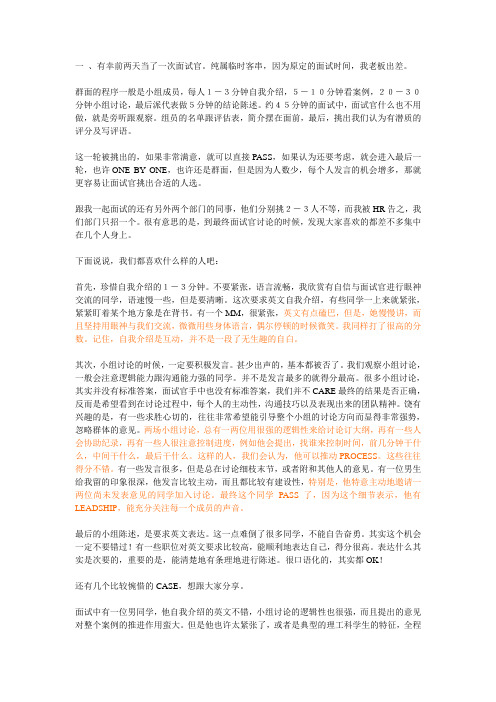
一、有幸前两天当了一次面试官。
纯属临时客串,因为原定的面试时间,我老板出差。
群面的程序一般是小组成员,每人1-3分钟自我介绍,5-10分钟看案例,20-30分钟小组讨论,最后派代表做5分钟的结论陈述。
约45分钟的面试中,面试官什么也不用做,就是旁听跟观察。
组员的名单跟评估表,简介摆在面前,最后,挑出我们认为有潜质的评分及写评语。
这一轮被挑出的,如果非常满意,就可以直接PASS,如果认为还要考虑,就会进入最后一轮,也许ONE BY ONE,也许还是群面,但是因为人数少,每个人发言的机会增多,那就更容易让面试官挑出合适的人选。
跟我一起面试的还有另外两个部门的同事,他们分别挑2-3人不等,而我被HR告之,我们部门只招一个。
很有意思的是,到最终面试官讨论的时候,发现大家喜欢的都差不多集中在几个人身上。
下面说说,我们都喜欢什么样的人吧:首先,珍惜自我介绍的1-3分钟。
不要紧张,语言流畅,我欣赏有自信与面试官进行眼神交流的同学,语速慢一些,但是要清晰。
这次要求英文自我介绍,有些同学一上来就紧张,紧紧盯着某个地方象是在背书。
有一个MM,很紧张,英文有点磕巴,但是,她慢慢讲,而且坚持用眼神与我们交流,微微用些身体语言,偶尔停顿的时候微笑。
我同样打了很高的分数。
记住,自我介绍是互动,并不是一段了无生趣的自白。
其次,小组讨论的时候,一定要积极发言。
甚少出声的,基本都被否了。
我们观察小组讨论,一般会注意逻辑能力跟沟通能力强的同学。
并不是发言最多的就得分最高。
很多小组讨论,其实并没有标准答案,面试官手中也没有标准答案,我们并不CARE最终的结果是否正确,反而是希望看到在讨论过程中,每个人的主动性,沟通技巧以及表现出来的团队精神。
饶有兴趣的是,有一些求胜心切的,往往非常希望能引导整个小组的讨论方向而显得非常强势,忽略群体的意见。
两场小组讨论,总有一两位用很强的逻辑性来给讨论订大纲,再有一些人会协助纪录,再有一些人很注意控制进度,例如他会提出,找谁来控制时间,前几分钟干什么,中间干什么,最后干什么。
百威ai面试案例模板

百威ai面试案例模板
百威的ai面试难度相对不大,都是常见的宝洁八大问的题目。
笔试和AI面看自己能力,靠不了别人。
AI面9个问题,英文录制视频回答,具体和宝洁八大问感觉差不多。
随后大概两周多收到一面通知,45分钟做一个为原有的portfolio添加新产品的问题,7分钟presentation用英文。
感觉自己在45分钟里面时间并没把控好。
presentation感觉自己讲的还过得去,但是就是45分钟没有整理出来一个很漂亮的数字,如果能利用好时间,拿到理想的结果,就能应该发挥的更好。
最后一个是为什么想加入ABinBev。
发出来攒个人品,欢迎提问。
百威ai面试真题
在两分钟内,请作简单自我介绍并告诉我们你为啥想申请百威。
同时告诉我们你所取得主要成就。
你是不是一个非常有进取心的人?你给自己设定过的在和他人竞争中取胜的最挑战的目标(个人或者工作上的)是啥?你当时是如何达成这个很挑战的目标的?
请告诉我一个例子你在很困难的情况下仍然需要按照政策/流程/规定来严格执行。
你当时觉得如何?请描述当时的情况,你的行动方案和最后结果。
面试问题及答案案例
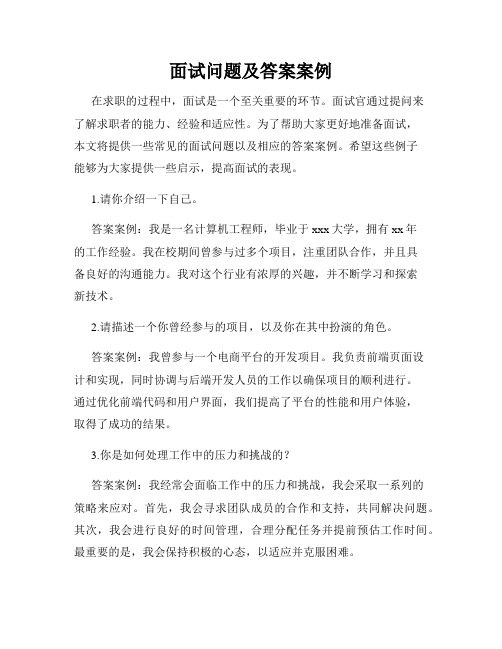
面试问题及答案案例在求职的过程中,面试是一个至关重要的环节。
面试官通过提问来了解求职者的能力、经验和适应性。
为了帮助大家更好地准备面试,本文将提供一些常见的面试问题以及相应的答案案例。
希望这些例子能够为大家提供一些启示,提高面试的表现。
1.请你介绍一下自己。
答案案例:我是一名计算机工程师,毕业于xxx大学,拥有xx年的工作经验。
我在校期间曾参与过多个项目,注重团队合作,并且具备良好的沟通能力。
我对这个行业有浓厚的兴趣,并不断学习和探索新技术。
2.请描述一个你曾经参与的项目,以及你在其中扮演的角色。
答案案例:我曾参与一个电商平台的开发项目。
我负责前端页面设计和实现,同时协调与后端开发人员的工作以确保项目的顺利进行。
通过优化前端代码和用户界面,我们提高了平台的性能和用户体验,取得了成功的结果。
3.你是如何处理工作中的压力和挑战的?答案案例:我经常会面临工作中的压力和挑战,我会采取一系列的策略来应对。
首先,我会寻求团队成员的合作和支持,共同解决问题。
其次,我会进行良好的时间管理,合理分配任务并提前预估工作时间。
最重要的是,我会保持积极的心态,以适应并克服困难。
4.谈谈你对团队合作的理解。
答案案例:团队合作对于项目的成功非常关键。
我认为团队合作需要良好的沟通和协调能力,以确保每个人都在同一个方向上努力。
我善于倾听他人的意见并提供建设性的反馈,鼓励团队成员充分发挥自己的优势。
我相信通过团队合作,我们可以共同实现更大的目标。
5.请分享一次你在工作中遇到的挑战,并介绍你是如何解决的。
答案案例:在一个项目中,我们面临了严峻的时间压力和技术难题。
为了解决这个挑战,我与团队成员紧密合作,制定了详细的项目计划,并分工合作。
我们找到了一种更高效的解决方案,并与其他团队协调和沟通,最终成功地按时完成了项目。
6.你是如何持续学习和提升自己的技能的?答案案例:我认为学习是一个持续的过程,我会定期参加行业技术研讨会和培训课程,以更新和拓宽我的知识。
10个常见的压力面试题及回答
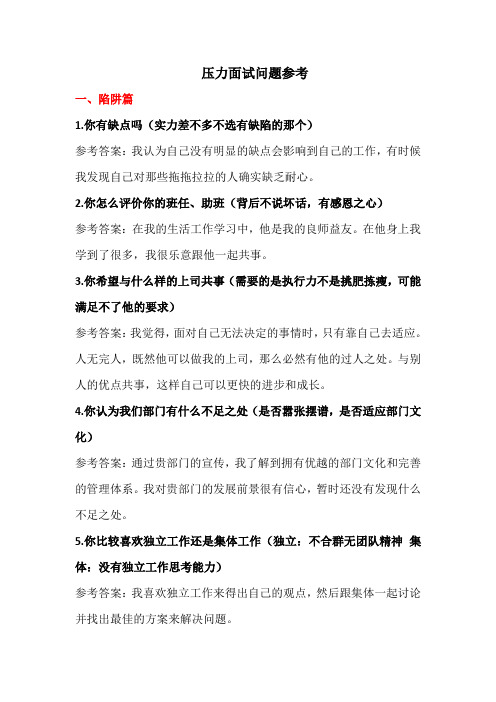
压力面试问题参考一、陷阱篇1.你有缺点吗(实力差不多不选有缺陷的那个)参考答案:我认为自己没有明显的缺点会影响到自己的工作,有时候我发现自己对那些拖拖拉拉的人确实缺乏耐心。
2.你怎么评价你的班任、助班(背后不说坏话,有感恩之心)参考答案:在我的生活工作学习中,他是我的良师益友。
在他身上我学到了很多,我很乐意跟他一起共事。
3.你希望与什么样的上司共事(需要的是执行力不是挑肥拣瘦,可能满足不了他的要求)参考答案:我觉得,面对自己无法决定的事情时,只有靠自己去适应。
人无完人,既然他可以做我的上司,那么必然有他的过人之处。
与别人的优点共事,这样自己可以更快的进步和成长。
4.你认为我们部门有什么不足之处(是否嚣张摆谱,是否适应部门文化)参考答案:通过贵部门的宣传,我了解到拥有优越的部门文化和完善的管理体系。
我对贵部门的发展前景很有信心,暂时还没有发现什么不足之处。
5.你比较喜欢独立工作还是集体工作(独立:不合群无团队精神集体:没有独立工作思考能力)参考答案:我喜欢独立工作来得出自己的观点,然后跟集体一起讨论并找出最佳的方案来解决问题。
6.你是否喜欢部长的职位(喜欢:有威胁不喜欢:无大志不想当将军的士兵不是好士兵)7.参考答案:我希望上司被提拔以后,我可以在他原来的位置上继续把他的精神发扬光大。
8.7. 对这项工作:第二届创意主题班会征集大赛,你有哪些可预见的困难(是否有畏难情绪)9.参考答案:挑战和机遇是并存的,遇到问题解决问题才会让人成长的更快。
我相信方法总比困难多,我有信心克服和解决工作中的困难。
10.8. 如果你离开其他竞选部门选择心理部,你认为其他部门会有什么反应(不在乎价值问题)11.参考答案:当我最初跟老板表达我想离开时,他很不解,甚至有些不舍遗憾。
经过一番深层次的沟通后,他赞同了我的选择。
并且很大度的跟我说,以后大家还是很好的朋友和同行。
9.工作中你认为什么样的决定犹为难做参考答案:我没发现有什么决定特别'难'做,但确实有时做一些决定要比做其他的决定要多费一些脑筋,多做些分析。
【面试专题】搞定面试,45分钟能成“面霸”
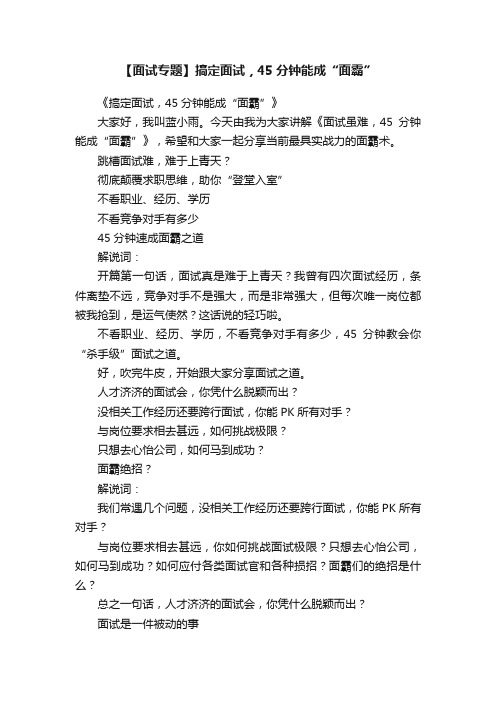
【面试专题】搞定面试,45分钟能成“面霸”《搞定面试,45分钟能成“面霸”》大家好,我叫蓝小雨。
今天由我为大家讲解《面试虽难,45分钟能成“面霸”》,希望和大家一起分享当前最具实战力的面霸术。
跳槽面试难,难于上青天?彻底颠覆求职思维,助你“登堂入室”不看职业、经历、学历不看竞争对手有多少45分钟速成面霸之道解说词:开篇第一句话,面试真是难于上青天?我曾有四次面试经历,条件离垫不远,竞争对手不是强大,而是非常强大,但每次唯一岗位都被我抢到,是运气使然?这话说的轻巧啦。
不看职业、经历、学历,不看竞争对手有多少,45分钟教会你“杀手级”面试之道。
好,吹完牛皮,开始跟大家分享面试之道。
人才济济的面试会,你凭什么脱颖而出?没相关工作经历还要跨行面试,你能PK所有对手?与岗位要求相去甚远,如何挑战极限?只想去心怡公司,如何马到成功?面霸绝招?解说词:我们常遇几个问题,没相关工作经历还要跨行面试,你能PK所有对手?与岗位要求相去甚远,你如何挑战面试极限?只想去心怡公司,如何马到成功?如何应付各类面试官和各种损招?面霸们的绝招是什么?总之一句话,人才济济的面试会,你凭什么脱颖而出?面试是一件被动的事如何应付面试官各种损招?现场请你做签字笔、打火机、空调厂家的销售解说词:我在乳业集团招聘销售时,经常把一支笔放到应聘人眼前:假设你是这家签字笔厂家的销售,请把这款普通签字笔卖给我,但不要让我开口说话,给你一分钟思考时间,开始吧。
哇,真刀真枪的实战,气氛陡然紧张起来,很多人当场晕过去了,过关的人还没庆幸完自己的运气,第二题又呼啸而至:你看我是什么样的人,打算如何搞定,把生意做成?哇,我看到很多人像晚上摸黄鳝——难下手啊。
面试是一件被动的事,被人问来问去,绕东绕西,额的神啊,场面上总被动挨打不是好事,怎么办?想找找面试书籍看看吧,发现多如牛毛,砖头厚,但大都在谈如何应付面试官各种损招,根本记不住,因为被动接招的思路愚笨啦。
情景面试题目100及最佳答案

情景面试题目100及最佳答案面试题目一:请描述一个你遇到的挑战,并说明你是如何克服它的。
回答:在我之前的工作中,我曾经面临一个项目进度紧迫的挑战。
由于各种原因导致项目延期,我被分派到该项目团队以解决这个问题。
我采取了以下步骤来克服挑战:首先,我仔细分析了项目的关键节点和延期的原因。
通过与团队成员的讨论和相关数据的分析,我确定了导致项目延期的主要因素。
其次,我与团队成员一起制定了一个详细的项目进度计划,对每个阶段的任务进行了明确的分工和排期。
我设定了具体的里程碑,以监控和评估项目的进展。
在项目执行过程中,我密切与团队成员合作,确保每个人都清楚自己的任务和角色。
我定期召开会议,与团队分享项目进展和存在的问题,并提供解决方案。
最后,我积极推动项目进度,确保各项任务按时完成。
我提供了额外的支持和协助,帮助团队成员克服遇到的困难。
同时,我定期与项目负责人沟通和报告项目进展。
通过以上的努力,我们成功地将项目按时交付,并获得了领导层的表扬。
这次经历让我明白了解决问题的重要性,并提升了我的项目管理和团队合作能力。
面试题目二:请谈谈你在团队合作中的角色,以及你如何与团队成员合作的经验。
回答:在过去的工作中,我经常参与各种团队合作项目,并担任不同的角色。
我发现,在团队中扮演着不同的角色可以促进团队的协作和进步。
首先,我通常会积极主动地提出建议和参与讨论。
我善于倾听他人的意见和观点,并对不同的意见进行充分的思考和分析。
我尊重团队成员的个人观点和专业领域知识。
其次,我总是尽力承担自己的分内工作,并愿意协助他人完成任务。
我善于与团队成员合作,分享资源和信息。
我会经常与其他成员保持沟通,了解他们的需求和困难,并提供帮助和支持。
另外,我也善于组织和管理团队的工作。
在一个项目中,我在团队中担任领导角色,并负责协调各个成员的工作。
我根据每个人的强项和专业知识进行任务分配,并确保项目进展顺利。
最后,我在工作中注重团队的凝聚力和沟通效果。
学生会面试之情景模拟面试样题

第一组:总计35分钟一、讨论主题:“鹏程小学”是否应该撤销二、题目的背景材料:某大城市外来务工人员较多,为了解决外来务工人员的子女就学问题,一些外来务工人员子弟学校开办了,“鹏程小学”就是其中之一.但是由于外来务工人员收入不高,所以学校的教育设施比较简陋,师资力量薄弱,卫生状况很差.而且鹏程小学未在该城市教育部门登记备案,属于擅自开办.根据教育部门已有的文件,凡是未登记备案的教学机构一律要予以取缔.但是一旦取缔鹏程小学这样的外来务工人员子弟学校,大量外来务工人员的子女将面临失学辍学的危险.现在该城市教育部门对此事作了认真地研究,在研究中出现了如下两种意见1、撤销鹏程小学的教学资格.2、破例保留鹏程小学的教学资格.如果你们是该城市教育部门的负责人,将按哪种意见处理三、应试者须知:1、应试者接到“讨论题”后,用5分钟时间读题、拟写讨论提纲;2、每人限2分钟阐述自己的基本观点;3、依次发言结束后,应试者用10分钟时间进行自由交叉辩论.4、辩论结束后,应试者将拟写的发言提纲交给主考官,应试者退场.第二组:总计45分钟无领导小组面试题题目:做一个成功的领导者,可能取决于很多的因素,比如:善于鼓舞人能充分发挥下属优势处事公正能坚持原则又不失灵活性办事能力强幽默独立有主见言谈举止有风度有亲和力有威严感善于沟通熟悉业务知识善于化解人际冲突有明确的目标能通观全局有决断力请你分别从上面所列的因素中选出一个你认为最重要和最不重要的因素.1、应试者接到“讨论题”后,用5分钟时间读题,然后将答案写在纸上,每人宣读自己的基本观点.2、应试者用30分钟时间就这一问题进行讨论,并在结束时拿出一个一致性的意见,即得出一个你们共同认为最重要和最不重要的因素.3、派出一个代表来汇报你们的意见,并阐述你们作出这种选择的原因.如果到了规定的时间你们没有得出一个统一的意见,那么你们每一个人的分数都要相应的减去一部分.4、讲解结束后,考官提问5分钟,问题不限;5、面试结束后,应试者将拟写的发言提纲交给主考官,应试者退场.第三组:总计40分钟随着国家人民生活水平的不断提高,电影市场已经成为我国新兴崛起的,影响巨大的新兴市场,可是近年来,一些所谓的商业大片却往往在票房大好的同时背负着种种骂名,相反,一些真正的艺术电影却慢慢的淡出了人们的视线,电影制作,到底是哪方面更重要这个值得我们深思.请以下面的两个对立方面作为题目,得出自己和团队的观点.电影制作,艺术价值应大于商业价值;电影制作,商业价值应大于艺术价值.一、准备时间15分钟二、开篇立论正方一辩开始每方2分钟三、自由辩论阶段:双方轮流发言,正方先开始15分钟四、总结陈词先反后正每方2分钟第四组:总计40分钟策划校园辩论赛要求:采取小组讨论形式,准备20分钟,自行拟定具有较强可操作性的完整策划,可从文案、后勤保障、联络、宣传等角度进行分工.讨论结束需对策划进行讲解,限时讲解10分钟.讲解结束后,考官提问5分钟,问题不限;注意:每人均需根据自身特点承担活动中的某一角色.。
用友面试经验总结篇

用友面试经历总结篇用友面试经历总结篇今天我到了用友软件面试,这是我毕业以来第二次的面试经历,这次我应聘用友软件的java程序员,在45分钟的试卷里面,不但没有全部完成,而且我发现了我很多数据库知识已经忘记了,用友面试经历总结篇。
不过这个的考试过程我还是很平静,可能在我去面试的时候已经做了最坏的打算的原因吧。
别人说失败乃是成功之母,看得多了,听得也多了,跟别人说得也多了。
不过今天当这句话落在自己身上的时候,心真的很痛很痛。
痛醒了我,我不能浪费时间了,还有很多事情还没有完成,还有很多努力就可以完成梦想没有去完成,我不能停下来,我要吞下眼泪不让别人发现向前跑。
我有点累了,我需要一晚时间的休息,这一晚的时间很珍贵,我要珍惜。
问题如下:1.对用友的理解;2.SOA;3.工作经历;4.假如一个工程开发过程中你发现了与需求偏离了,但是已经开发了一定程度了,这时候你如何客户沟通,如何处理,资料共享平台《用友面试经历总结篇》(s://..)。
我对问题4的`答复:在开发过程中我说假如我遇到问题我会立即向上级反映,让上级可以立即对现有的方案调整,将低工程失败的风险汪静教师的意见:不是问你怎么和客户沟通,你怎么提上级呢?这说明你没有领会他的意思他会觉得你在沟通才能方面欠缺,你应该说先搞清楚到底什么原因出现了偏向,无论如何不能影响工程的进度。
假如是客户方面,你要去沟通好;假如是你们自己方面,但是假如不影响工程,你们应该尽量说服客户承受,实在不行,再不影响工程进度的情况下,再按照客户的去改。
还有答这个之前可能应该理解用友的企业文化,到底是把客户的需求放在第一位,还是要以工程为主;以后听问题要听懂,考虑一下在答复,不要那么着急答,先揣摩对方的意思,整理好思路在答。
总结:为什么我没有教师考虑的有深度呢。
我以后要注意三思而后行。
【案例面试】管理咨询MBB面试过程

【案例面试】45分钟,你会经历什么?注:部分资料来源于某咨询公司。
要想进入MBB,一般需要经过4到6个一对一的案例面试。
每个案例面试由一位项目经理或合伙人作为面试官,每个面试的时间都是45分钟。
只有每一个面试官都认可你的面试表现,你才有可能进入下一轮和最终拿到offer。
通常情况下,45分钟的案例面试分为三个部分:行为面试、案例分析和问答环节。
一、行为面试(5-10分钟)行为面试主要围绕你的个人背景展开。
面试官希望在面试过程中能对你有进一步的了解,看你是否适合该公司。
例如,面试官可能要求你介绍,在以往的某个团队环境中,你通过何种方式在团队中发挥作用。
面试官也可能请你谈谈,你曾经怎样克服障碍,说服其他人接受一个他们原本极力反对的决策。
面试官也可能只想了解一下你为什么会选择到该公司工作。
二、案例分析(30分钟)案例分析是每场面试的核心。
面试官会通过一个案例研究,让你有机会展示和证明解决问题的技能。
因为这些案例基本上是基于面试官自己亲身经历过的客户项目。
而借此机会,你也能够对该公司的战略咨询工作有独特而深入的了解。
案例研究通常是给出一个商业问题,需要你和面试官共同解决。
解决这样的问题,通常不需要非常丰富的行业和流程专业知识。
面试官给出的案例通常也没有正确与错误的答案。
相对最终的解决方案而言,面试官更看重你在分析过程中提出的问题和你的思考过程。
下面我们就举一个案例分析的例子,让大家感受下这个神奇的30分钟。
值得注意的是,案例面试通常是Interviewee-led。
也就是说,在面试官简单说完案例的背景后,剩下的就都靠应聘者来主导。
除非应聘者主动询问,面试官一般不会主动提供信息或者数据。
因此,应聘者需要知道该问什么问题,组织自己的分析框架,向面试官获取数据,进行分析和为客户提供建议。
以下黑色部分是面试官的对白,蓝色部分是应聘者的对白。
(首先,面试官简要说明背景)Your client is GenCo, a large, international,diversified company with a health care division that produces a wide variety ofmedical instruments and related services. Five years ago, it expanded into thehealth care software industry by purchasing MedCount, which markets administrative systems to largeU.S.hospitals. These systems are designed primarily for back-office functions; theyare not designed for managing patients or providing other physician and technicalsupport. Since it was purchased, the software division has failed to deliverthe growth needed to justify the multiple GenCo paid for it. GenCo feels it hasalready squeezed margins as much as possible, and now is looking for new salesopportunities. MedCount turned to BCG to help identify potential ways toincrease revenues. How would you approach this problem?(接下来,应聘者需要和面试官确认自己对案例的理解)First, let me make sure I understand theproblem. The parent company produces medical devices and services, but before theacquisition was not involved in health care software. The company itpurchased,MedCount, sells only administrative systems software to large hospitals. It isnow looking for opportunities to increase revenues. That is correct.Could I take a moment to jot down a few thoughts?Sure, that would be fine.(然后,应聘者需要花几分钟写出来分析该案例的框架)I would suggest using the following framework:∙ First, I'd want to understand the market size and growthrates for MedCount's market and related software markets.∙ Next, I would like to explore the competition and theirmarket shares.∙ Third, I would like to examine customer requirements andthen, giventhose external conditions, look at the division'scapabilities tounderstand how well prepared it is to meet theneeds of the marketplace.(接下来,应聘者将根据自己的分析框架,对案例展开分析)That sounds fine. So what do you want to knowabout the market?Well, the first hurdle would be to identifythe markets the company wouldbe interested in. Besides administration systems,what other types ofmedical software systems do large hospitals purchase?There are many software systems, but for thesake of time, the team focusedon three primary markets: administration systems,patient administration, andphysician support systems.What do those systems do?Patient administration includes systems likeadmissions and tracking.Physician support systems are more specialized, forindividual physicianprocedures.I would like to know how large each marketis and how fast each isgrowing. I would use secondary sources such as pressreleases, analystreports, and published market studies, to obtain this information.Great! That is what we did during the marketstudy. Our information revealedthe following market sizes and growth rates.Administration Patient administration Physician support Market size ($M);1,5001,0001,200Growth rate5%5%12%From a size and growth perspective, physiciansupport systems lookslike a very attractive market. I'd like to know a littleabout the customers themselves. The client is currently targeting largehospitals.Approximately what percentage of the market do they represent?We were unable to get an exact break down,but we know that these hospitalsmake up the vast majority of the total medicalsoftware market.That would make sense, since the more sophisticatedprocedures at ahospital might necessitate more advanced software solutions. Iknow thatthere have been a lot of changes in the industry as a result ofmanagedone. I would want to look at their financials, annual reports,and press releases to find out a bit more about their strategy in each of theseareas. You'd find that they recently enteredthese noncore markets. Why might they have done that?Perhaps, like our client, each had a strongposition in its own segment, HTI in patient administration and HCS SoftwareSystems in physician support. Maybe they too decided to branch out into theother segments to find additional growth.That is a very good hypothesis. Let's say thereis evidence in the sources you consult that supports your assertion.Well, if that were true, these two companiescould be a threat not only in the other two segments, but also in our client'ssegment, administrative systems. It looks as if the client is slowly losingmarket share in its segment, since it is growing more slowly than its market.Good observation.The market and competitor trends couldalso suggest that the client may want to enter these other markets. Inparticular, the physician support market looks attractive, given it has high growthand lack of a dominant competitor. The higher gross margins may provide attractivereturns on the necessary investment in software development.However, the patient administration marketmay also be attractive. Although it is more concentrated and offer slowermargins than physician support, the client may be able to enter this segmentwith a smaller up-front investment. Given the trend toward upgrading existingcomputer systems, it may be important for MedCount to have a product offeringin each of the three market segments. That should not be too difficult, sincethe company is already in the software industry. Perhaps, but you should think a littlemore closely about these types of software. Are all software systems alike?Well, let me think about that for amoment. I suspect patient administration would have relatively low entry barriers.From your earlier description, these systems appear to be pretty basic, dealingprimarily with admissions and patient tracking. However, the entry barriersinphysician support might be higher, since these systems are more complex andthere are probably multiple systems for the various physician procedures. Iguess it would be harder to get into those types of systems.That would make sense.Since the company might want to go into onlysome of the segments, I would want to know how important it is to have productsin all three segments. Do we know if the competitors are marketing heirproducts as a bundle?How might you find that out?Since it would be difficult to talk to acompetitor directly, I would probably target a competitor's customer, particularlyone that just converted from our client's software.Let's say you get an interview with a customerthat recently switched to HTI. You discover that the competitor was offering ita better pricing deal and service for software products in all three segments.How were MedCount's software and serviceperceived in relation to those of competitors?The customer thought that its administrativesystems were adequate, "the old standby," but not stellar.Were there any other key reasons it switchedfrom MedCount's system? When it decided to upgrade its systems, ittried to contact MedCount, but could never get a representative to describe itsoptions.Interesting. How did HTI perform?The HTI representative had heard that the companywas considering switching software vendors and provided a sales representativeto pitch HTI's administrative product the next day.It definitely sounds as if there was a problemwith the sales function and that customer relations need to be improved,particularly for the larger hospital chains. There also seems to be anadvantage from both a marketing and sales perspective in having multiplesoftware products. I would want to confirm those views by doing furtherinterviews.Let's say further interviews support thoseassumptions.Since we have already looked at theexternal conditions, I would like to move on to the client itself. I'd like to knowmore about its marketing and selling organization as well as its software developmentskills.So far, we knowthat our client offers administrative software and that there may be a problemwith sales and marketing. Could you tell me a little about the marketingdepartment?The marketing department is organized regionally.Teams are assigned to hospitals within each state or geographic region, such asNew England.That could explain some of the problems withMedCount's marketing and sales. If hospital purchasing is centralized, the marketingorganization may be outdated. Does the company have any teams dedicated to thefour or five biggest hospital networks?No, there are no dedicated teams. They talkedabout doing that for a while, but it conflicted with the regional structure ithad in place.With regard to software, does thecompany feel it has any strengths or weaknesses?It feels that their administrative productis very strong ("best of breed") and is the dominant technology. Also,the product is modular in design, which allows for easier upgrades. Althoughthe company has never branched out into other market segments, the softwaredevelopers believe that certain modules could be used to build the foundationfor other administrative software programs. The company feels customer supportis also an area in which it excels.(最后,应聘者需要对案例分析进行总结,并为“客户”提供建议)Let's start with our client's market. Theclient dominates the administrative software market, which is fairly large butgrowing slowly, and the company appears to be slowly losing market share. Patientadministration is also growing relatively slowly.Both markets are relatively concentrated andappear to offer lower margins than physician support. The physician support marketis large and less concentrated, and could potentially provide higher margins,but would require a larger investment. The hospital market itself is becomingmore concentratedand is pushing to consolidate vendors. The purchasing agentis often the same for the three types of software.Looking at our client's competitors, two,HTI and HCS Software Systems, appear to be particularly threatening. Each has adominant position in one segment and is branching out into other areas. Theyappear to be marketing their products and services as a bundle and are usingservice as a key point of differentiation.The client offers only one type of systemand appears to have some weaknesses in its marketing organization, particularlyin marketing to the larger hospital networks, which offer the most promisingmarket opportunities.How would you recommend proceeding?The first priority should be to fix the marketingorganization, particularly for the large hospital networks. MedCount will havetrouble expanding into new markets if it can't defend its current position andshore up its existing customer relationships. There should be a team dedicatedto each of the major chains. The client should also look at improving customertracking so that it is clear when its customers are going to upgrade. Thereshould also be clear contacts so that the customer can easily keep in touch withMedCount.Next, I would recommend that the client exploreentering the other market segments by leveraging its dominant position inadministrative systems. At first glance, patient administration does not appearto be very attractive, with slow growth, low margins, and large, dominantcompetitors. There appears to be some advantage, however, in having productsacross the product range. I would recommend that we interview some of MedCount'sexisting customers to better understand their needs and future IT requirements.If the customer base is interested in one software provider for bothback-office administration and patient administration functions, this segmentlooks promising.If the client does decide to enter this market,it should look at thelowest-cost method of entry, either developing a productinternally or acquiring a competitor. The modular design of its existingadministrativesoftware suggests internal development of the patient administrationproduct may be the way to go, but we would need a more thorough comparison ofthe internal development and acquisition options, including both cost and timeto market. I think that physician support offers our client an exciting growthopportunity, given its high margins, high growth, and fragmented competition. Iwould definitely think about an acquisition strategy, since the client may lackthe technical capabilities to enter this specialized market. I would recommendgoing for one of the larger companies, as that would give the client a strongerposition. Smaller companies would probably not offer an important enoughposition in the market. More research would be needed, however, for us tobetter understand the intricacies of the market and each potential acquisition.Those are very interesting conclusions. Thankyou.三、问答环节(5-10分钟,具体情况取决于45分钟里剩下多少时间)问答环节由应聘者向面试官提问。
【留学生招聘】联合利华 MKT summer intern面试小记

【留学生招聘】联合利华 MKT summer intern面试小记这是来自中南财经政法大学市场营销专业一位同学的面经,他拿到了今年联合利华暑期实习的offer。
感谢这位同学的无私分享,也希望就像他所说的,“抛砖引玉“,希望能有更多的分享,让后来者可以有所借鉴。
以下是正文。
---------------------------------------------------------写在前面:这篇文章也算不上什么面经,只是记录一下这段难忘的回忆,还有一些自己的心得体会。
感觉财大很少有U家P家的相关文章,MKT的就更少了,应该是大神们隐藏的比较深吧,所以就抛砖引玉和大家分享一下。
相信很多志在MKT的小伙伴跟我一样,都把Unilever和P&G当做自己的dream company。
确实在MKT领域,这两家的地位不必多说,每年的intern数量也很少。
今年U家summerintern总共13000多人报名,最后offer 100个左右,MKT貌似只有10个左右,竞争还是相当惨烈的。
只能说,要拿到offer,不仅需要实力,也需要一些运气和缘分。
几天前终于接到offer的电话,竟然意想不到的淡定,可能也是心态比较好吧。
总之,两个月的实习求职,付出了太多太多,在这一刻都没有遗憾了。
先说说整个面试的过程吧,U家的summer intern招聘分为三大部分:网申、电面、AC。
其中最重要的AC是一整天,分为两部分,上午是8人无领导的case study,下午是face to face 的final。
1、网申网申和大部分外企一样,填表格类型,全英文。
根据各路大神的经验,英文简历千万不能直译中文简历,要重新按英文的思路做一份。
写好之后,最好能让在欧美有求职经历的人帮忙修改。
我是找了在美国的同学帮忙,最后果然跟我自己的版本区别巨大。
另一方面,就是非常重要的open question,这个HR应该是会仔细看的,在final的时候,也是整张简历包括open question都会打印出来供面试官参考(从侧面反映英文写作能力,我可能也是靠这个弥补了一些口语的硬伤)。
面试问题及答案案例

面试问题及答案案例尊敬的应聘者,无论您是刚刚步入职场的小白还是已经拥有多年经验的老兵,面试是一种重要的考察方式。
下面,给大家提供一些可能会出现在面试中的问题和合理的答案案例,供大家参考:问题1:告诉我一下你的基本情况以及个人职业规划?答案:我是某某大学XX专业的毕业生,接下来我参加了某某公司的实习,在实习期间,我学习了一些实用的技能和知识,并且认为自己现在已经具备在贵公司的这个职位上工作的能力。
我计划在未来的五年内成为一个熟练的XXX职位,并且有能力领导和协调一个团队。
问题2:为什么想要加入我们的公司?你有哪些优点能够为公司做出贡献?答案:我对贵公司的产品/服务一直很感兴趣,我认为贵公司的文化和价值观非常契合我的价值观,并且我相信自己可以在这个工作岗位上做出极大的贡献。
我的优点是XXX(比如良好的团队合作能力、优秀的沟通能力或者较高的工作效率等),我会尽力发挥自己的优势,为公司的发展做出努力。
问题3:你在某个项目中的角色是什么?你是如何解决或者处理困难的?答案:在那个项目中,我承担了XXX的角色,我努力学习技能,在公司的其他同事的帮助下,我可以熟练地完成我的职责。
在项目的过程中,出现了YY的困难,我们组织了一个小组来解决这个问题,我参与了解决方案的制定并且尽了自己的一份力,最终我们成功地解决了这个问题。
问题4:你认为自己的缺点是什么?你如何去解决或者弥补这个缺点?答案:我觉得我的缺点是有点缺乏经验和知识以及缺乏一些专业技能(或者其他自己真实存在的问题)。
对于这个问题,我会更加勤奋地学习和了解专业知识,同时我也会主动寻求其他同事和领导的帮助和指导,以期在这个方面得到改善。
问题5:你有什么职业发展的计划或者安排?答案:我希望在未来的工作中能够逐渐成为可以独立负责多部门/项目的主管,我相信这个目标可以通过不断地学习和提高自己的管理和沟通能力来实现。
我会努力争取公司内部的机会来接受更多的培训和教练,并且定期调整我的计划来保证自己在正确的道路上持续发展。
HSBC面试经验
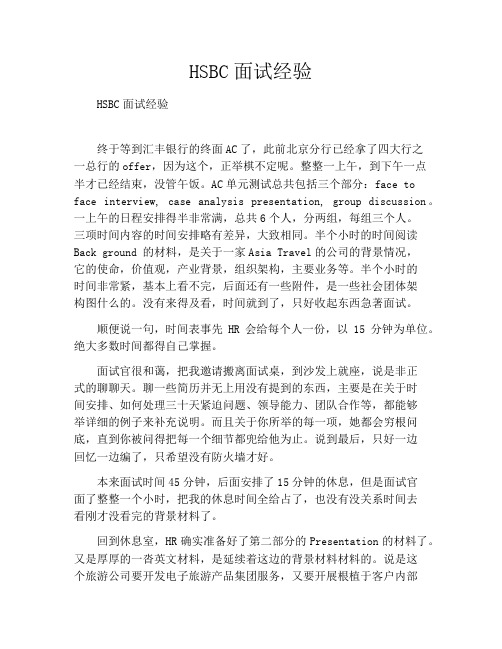
HSBC面试经验HSBC面试经验终于等到汇丰银行的终面AC了,此前北京分行已经拿了四大行之一总行的offer,因为这个,正举棋不定呢。
整整一上午,到下午一点半才已经结束,没管午饭。
AC单元测试总共包括三个部分:face to face interview, case analysis presentation, group discussion。
一上午的日程安排得半非常满,总共6个人,分两组,每组三个人。
三项时间内容的时间安排略有差异,大致相同。
半个小时的时间阅读Back ground 的材料,是关于一家Asia Travel的公司的背景情况,它的使命,价值观,产业背景,组织架构,主要业务等。
半个小时的时间非常紧,基本上看不完,后面还有一些附件,是一些社会团体架构图什么的。
没有来得及看,时间就到了,只好收起东西急著面试。
顺便说一句,时间表事先HR会给每个人一份,以15分钟为单位。
绝大多数时间都得自己掌握。
面试官很和蔼,把我邀请搬离面试桌,到沙发上就座,说是非正式的聊聊天。
聊一些简历并无上用没有提到的东西,主要是在关于时间安排、如何处理三十天紧迫问题、领导能力、团队合作等,都能够举详细的例子来补充说明。
而且关于你所举的每一项,她都会穷根问底,直到你被问得把每一个细节都兜给他为止。
说到最后,只好一边回忆一边编了,只希望没有防火墙才好。
本来面试时间45分钟,后面安排了15分钟的休息,但是面试官面了整整一个小时,把我的休息时间全给占了,也没有没关系时间去看刚才没看完的背景材料了。
回到休息室,HR确实准备好了第二部分的Presentation的材料了。
又是厚厚的一沓英文材料,是延续着这边的背景材料材料的。
说是这个旅游公司要开发电子旅游产品集团服务,又要开展根植于客户内部的客户代表。
介绍了一堆市场和及后竞争对手的背景资料而后,问作为公司一个技术顾问子公的项目经理,如何提出建议,如何举出海外市场措施等。
一个小时的打字时间,连带做好Slides,给了五张纸,两根笔,随意使用。
国有企业面试实录与亲历笔记

中国人寿保险面试亲历:四个考官轮流提问安小姐,某大学硕士毕业有四个面试官考我。
先是四个人轮流问我问题。
第一个问题是,谈谈你自己,并说一下你最近五年的职业发展规划是什么?这样的问题要表现出自己积极向上、自信阳光的一面,让考官觉得你是一个喜欢主动接受、自觉学习新知识的人。
而职业规划要做到符合自己的实际,不显得过于好高骛远。
第二个主考官问我的问题是,你是否已经拥有实现你目标的态度、知识、技能和计划,它们分别是什么?这是一个很难回答的问题,遇到这样的情况你不能慌张,可以灵活变通一点。
我是这样说的:是否拥有这些是客观的事实,并非是我主观意识所决定的。
现阶段有了证明我成熟了,很好;若是没有,也没有关系,我还年轻,可以多学习,多积累。
考官对我的回答很满意,和旁边的考官点了一下头,面露微笑。
接下来两位考官是我所应聘部门的主管,他们对我进行了一下专业问题的考察,例如人们为什么会退保?当你不断接到客户投诉时,你会怎么办?这些问题是你展示专业技能的好时机,你回答的时候要尽量条理、全面,给考官留下一个好的印象,证明你的业务能力过关。
最后一个问题是:你准备在我们公司干多久?面试官这样问,是在考察应聘者的个人目标和公司的发展目标是否一致。
我就强调了自己的专一性格,希望不断提高自己的能力,为新的单位作出积极的贡献。
竟中国移动广州公司面试亲历:竟然问了个投资成本的问题孙先生,某大学毕业生从开始到结束,广州移动的面试共有4关。
第一关,一个HR美女问了我手头有没有广州的其他offer,我回答有广州普华的,过关。
第二关非常累,上午做了一个有关公文写作的笔试和性格能力测试就结束了。
下午的环节,先是给你一张卡片,上面记载着某人的资料(包括姓名、年龄、学历、个性、生活经历等),然后要求你对该卡片上的人做3分钟的英文介绍。
接着面试考官把12名应聘者分成两组,作了一个案例分析(有关新产品的市场推广)。
然后做一个即兴演讲(中文,每个人抽一个主题,3分钟准备,3分钟演讲。
市场分析师面试问题

市场分析师面试问题
不同的公司,不同的面试官,面试的流程和问题都是不一样的,下面分享给大家两个市场分析师面试的案例参考
面试一:
投递简历之后先后经历两轮面试,第一轮是电面比较突然在我上课的时候打来就直接开始面试了,除了一些基本信息的核对,其余几乎是全英文的,大概3-4个工作日后收到了线下面试的通知,只有LM一个人来面试,并且预约了不少于45分钟的时间,由于当时我的课程安排还很紧张,所以是下午五点进行的面试,谈话大约40分钟时间,开头用英语自我介绍,可能是我说的足够多也流利(准备过的,现场发挥口语没有这么好),后面的问题都是中文的了,主要针对简历上的经历进行提问,判断是否符合项目要求。
面试官问的面试题:
1.英语介绍自己
2.经历中最成功的事
3.老师对你的评价
4.简述某个项目的完整流程
5.职业规划,why this position
面试二:
先填了一张很详细的个人信息的表,面试分为3轮;
第一轮电话面试,
第二轮群面,先自我介绍再展开讨论,
第三轮需要到深圳面试
面试官问的面试题:
面试官提出的问题市场分析,竞品分析,swot,波特五力,对公司的了解有哪些;你有什么问题想问。
- 1、下载文档前请自行甄别文档内容的完整性,平台不提供额外的编辑、内容补充、找答案等附加服务。
- 2、"仅部分预览"的文档,不可在线预览部分如存在完整性等问题,可反馈申请退款(可完整预览的文档不适用该条件!)。
- 3、如文档侵犯您的权益,请联系客服反馈,我们会尽快为您处理(人工客服工作时间:9:00-18:30)。
【案例面试】45分钟,你会经历什么?注:部分资料来源于某咨询公司。
要想进入MBB,一般需要经过4到6个一对一的案例面试。
每个案例面试由一位项目经理或合伙人作为面试官,每个面试的时间都是45分钟。
只有每一个面试官都认可你的面试表现,你才有可能进入下一轮和最终拿到offer。
通常情况下,45分钟的案例面试分为三个部分:行为面试、案例分析和问答环节。
一、行为面试(5-10分钟)行为面试主要围绕你的个人背景展开。
面试官希望在面试过程中能对你有进一步的了解,看你是否适合该公司。
例如,面试官可能要求你介绍,在以往的某个团队环境中,你通过何种方式在团队中发挥作用。
面试官也可能请你谈谈,你曾经怎样克服障碍,说服其他人接受一个他们原本极力反对的决策。
面试官也可能只想了解一下你为什么会选择到该公司工作。
二、案例分析(30分钟)案例分析是每场面试的核心。
面试官会通过一个案例研究,让你有机会展示和证明解决问题的技能。
因为这些案例基本上是基于面试官自己亲身经历过的客户项目。
而借此机会,你也能够对该公司的战略咨询工作有独特而深入的了解。
案例研究通常是给出一个商业问题,需要你和面试官共同解决。
解决这样的问题,通常不需要非常丰富的行业和流程专业知识。
面试官给出的案例通常也没有正确与错误的答案。
相对最终的解决方案而言,面试官更看重你在分析过程中提出的问题和你的思考过程。
下面我们就举一个案例分析的例子,让大家感受下这个神奇的30分钟。
值得注意的是,案例面试通常是Interviewee-led。
也就是说,在面试官简单说完案例的背景后,剩下的就都靠应聘者来主导。
除非应聘者主动询问,面试官一般不会主动提供信息或者数据。
因此,应聘者需要知道该问什么问题,组织自己的分析框架,向面试官获取数据,进行分析和为客户提供建议。
以下黑色部分是面试官的对白,蓝色部分是应聘者的对白。
(首先,面试官简要说明背景)Your client is GenCo, a large, international,diversified company with a health care division that produces a wide variety ofmedical instruments and related services. Five years ago, it expanded into thehealth care software industry by purchasing MedCount, which markets administrative systems to largeU.S.hospitals. These systems are designed primarily for back-office functions; theyare not designed for managing patients or providing other physician and technicalsupport. Since it was purchased, the software division has failed to deliverthe growth needed to justify the multiple GenCo paid for it. GenCo feels it hasalready squeezed margins as much as possible, and now is looking for new salesopportunities. MedCount turned to BCG to help identify potential ways toincrease revenues. How would you approach this problem?(接下来,应聘者需要和面试官确认自己对案例的理解)First, let me make sure I understand theproblem. The parent company produces medical devices and services, but before theacquisition was not involved in health care software. The company itpurchased,MedCount, sells only administrative systems software to large hospitals. It isnow looking for opportunities to increase revenues. That is correct.Could I take a moment to jot down a few thoughts?Sure, that would be fine.(然后,应聘者需要花几分钟写出来分析该案例的框架)I would suggest using the following framework:∙ First, I'd want to understand the market size and growthrates for MedCount's market and related software markets.∙ Next, I would like to explore the competition and theirmarket shares.∙ Third, I would like to examine customer requirements andthen, giventhose external conditions, look at the division'scapabilities tounderstand how well prepared it is to meet theneeds of the marketplace.(接下来,应聘者将根据自己的分析框架,对案例展开分析)That sounds fine. So what do you want to knowabout the market?Well, the first hurdle would be to identifythe markets the company wouldbe interested in. Besides administration systems,what other types ofmedical software systems do large hospitals purchase?There are many software systems, but for thesake of time, the team focusedon three primary markets: administration systems,patient administration, andphysician support systems.What do those systems do?Patient administration includes systems likeadmissions and tracking.Physician support systems are more specialized, forindividual physicianprocedures.I would like to know how large each marketis and how fast each isgrowing. I would use secondary sources such as pressreleases, analystreports, and published market studies, to obtain this information.Great! That is what we did during the marketstudy. Our information revealedthe following market sizes and growth rates.Administration Patient administration Physician support Market size ($M);1,5001,0001,200Growth rate5%5%12%From a size and growth perspective, physiciansupport systems lookslike a very attractive market. I'd like to know a littleabout the customers themselves. The client is currently targeting largehospitals.Approximately what percentage of the market do they represent?We were unable to get an exact break down,but we know that these hospitalsmake up the vast majority of the total medicalsoftware market.That would make sense, since the more sophisticatedprocedures at ahospital might necessitate more advanced software solutions. Iknow thatthere have been a lot of changes in the industry as a result ofmanagedone. I would want to look at their financials, annual reports,and press releases to find out a bit more about their strategy in each of theseareas. You'd find that they recently enteredthese noncore markets. Why might they have done that?Perhaps, like our client, each had a strongposition in its own segment, HTI in patient administration and HCS SoftwareSystems in physician support. Maybe they too decided to branch out into theother segments to find additional growth.That is a very good hypothesis. Let's say thereis evidence in the sources you consult that supports your assertion.Well, if that were true, these two companiescould be a threat not only in the other two segments, but also in our client'ssegment, administrative systems. It looks as if the client is slowly losingmarket share in its segment, since it is growing more slowly than its market.Good observation.The market and competitor trends couldalso suggest that the client may want to enter these other markets. Inparticular, the physician support market looks attractive, given it has high growthand lack of a dominant competitor. The higher gross margins may provide attractivereturns on the necessary investment in software development.However, the patient administration marketmay also be attractive. Although it is more concentrated and offer slowermargins than physician support, the client may be able to enter this segmentwith a smaller up-front investment. Given the trend toward upgrading existingcomputer systems, it may be important for MedCount to have a product offeringin each of the three market segments. That should not be too difficult,sincethe company is already in the software industry. Perhaps, but you should think a littlemore closely about these types of software. Are all software systems alike?Well, let me think about that for amoment. I suspect patient administration would have relatively low entry barriers.From your earlier description, these systems appear to be pretty basic, dealingprimarily with admissions and patient tracking. However, the entry barriersinphysician support might be higher, since these systems are more complex andthere are probably multiple systems for the various physician procedures. Iguess it would be harder to get into those types of systems.That would make sense.Since the company might want to go into onlysome of the segments, I would want to know how important it is to have productsin all three segments. Do we know if the competitors are marketing heirproducts as a bundle?How might you find that out?Since it would be difficult to talk to acompetitor directly, I would probably target a competitor's customer, particularlyone that just converted from our client's software.Let's say you get an interview with a customerthat recently switched to HTI. You discover that the competitor was offering ita better pricing deal and service for software products in all three segments.How were MedCount's software and serviceperceived in relation to those of competitors?The customer thought that its administrativesystems were adequate, "the old standby," but not stellar.Were there any other key reasons it switchedfromMedCount's system? When it decided to upgrade its systems, ittried to contact MedCount, but could never get a representative to describe itsoptions.Interesting. How did HTI perform?The HTI representative had heard that the companywas considering switching software vendors and provided a sales representativeto pitch HTI's administrative product the next day.It definitely sounds as if there was a problemwith the sales function and that customer relations need to be improved,particularly for the larger hospital chains. There also seems to be anadvantage from both a marketing and sales perspective in having multiplesoftware products. I would want to confirm those views by doing furtherinterviews.Let's say further interviews support thoseassumptions.Since we have already looked at theexternal conditions, I would like to move on to the client itself. I'd like to knowmore about its marketing and selling organization as well as its software developmentskills.So far, we knowthat our client offers administrative software and that there may be a problemwith sales and marketing. Could you tell me a little about the marketingdepartment?The marketing department is organized regionally.Teams are assigned to hospitals within each state or geographic region, such asNew England.That could explain some of the problems withMedCount's marketing and sales. If hospital purchasing is centralized, the marketingorganization may be outdated. Does the company have any teams dedicated to thefour or five biggest hospital networks?No, there are no dedicated teams. They talkedabout doing that for a while, but it conflicted with the regional structure ithad in place.With regard to software, does thecompany feel it has any strengths or weaknesses?It feels that their administrative productis very strong ("best of breed") and is the dominant technology. Also,the product is modular in design, which allows for easier upgrades. Althoughthecompany has never branched out into other market segments, the softwaredevelopers believe that certain modules could be used to build the foundationfor other administrative software programs. The company feels customer supportis also an area in which it excels.(最后,应聘者需要对案例分析进行总结,并为“客户”提供建议)Let's start with our client's market. Theclient dominates the administrative software market, which is fairly large butgrowing slowly, and the company appears to be slowly losing market share. Patientadministration is also growing relatively slowly.Both markets are relatively concentrated andappear to offer lower margins than physician support. The physician support marketis large and less concentrated, and could potentially provide higher margins,but would require a larger investment. The hospital market itself is becomingmore concentratedand is pushing to consolidate vendors. The purchasing agentis often the same for the three types of software.Looking at our client's competitors, two,HTI and HCS Software Systems, appear to be particularly threatening. Each has adominant position in one segment and is branching out into other areas. Theyappear to be marketing their products and services as a bundle and are usingservice as a key point of differentiation.The client offers only one type of systemand appears to have some weaknesses in its marketing organization, particularlyin marketing to the larger hospital networks, which offer the most promisingmarket opportunities.How would you recommend proceeding?The first priority should be to fix the marketingorganization, particularly for the large hospital networks. MedCount will havetrouble expanding into new markets if it can't defend its current position andshore up its existing customer relationships. There should be a team dedicatedto each of the major chains. The client should also look at improving customertracking so that it is clear when its customers are going to upgrade. Thereshould also be clear contacts so that the customer can easily keep in touch withMedCount.Next, I would recommend that the client exploreentering the other market segments by leveraging its dominant position inadministrative systems. At first glance, patient administration does not appearto be very attractive, with slow growth, low margins, and large, dominantcompetitors. There appears to be some advantage, however, in having productsacross the product range. I would recommend that we interview some of MedCount'sexisting customers to better understand their needs and future IT requirements.If the customer base is interested in one software provider for bothback-office administration and patient administration functions, this segmentlooks promising.If the client does decide to enter this market,it should look at thelowest-cost method of entry, either developing a productinternally or acquiring a competitor. The modular design of its existingadministrativesoftware suggests internal development of the patient administrationproduct may be the way to go, but we would need a more thorough comparison ofthe internal development and acquisition options, including both cost and timeto market. I think that physician support offers our client an exciting growthopportunity, given its high margins, high growth, and fragmented competition. Iwould definitely think about an acquisition strategy, since the client may lackthe technical capabilities to enter this specialized market. I would recommendgoing for one of the larger companies, as that would give the client a strongerposition. Smaller companies would probably not offer an important enoughposition in the market. More research would be needed, however, for us tobetter understand the intricacies of the market and each potential acquisition.Those are very interesting conclusions. Thankyou.三、问答环节(5-10分钟,具体情况取决于45分钟里剩下多少时间)问答环节由应聘者向面试官提问。
